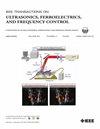A Deep Reinforcement Learning Based Region-Specific Beamformer for Sparse Arrays 3-D Ultrasound Imaging
IF 3.7
2区 工程技术
Q1 ACOUSTICS
IEEE transactions on ultrasonics, ferroelectrics, and frequency control
Pub Date : 2025-04-15
DOI:10.1109/TUFFC.2025.3560872
引用次数: 0
Abstract
Sparse arrays offer several advantages over other element reduction techniques for 3-D ultrasound imaging. However, the large interelement spacing in these arrays results in high sidelobe-related artifacts, which significantly degrade image quality and limit their application in 3-D ultrasound imaging. Adaptive beamformers have been proposed to mitigate sidelobe-related artifacts, but they often degrade speckle texture quality, resulting in unnaturally dark images. To overcome these limitations, we propose RSB-Net, a region-specific beamformer based on deep reinforcement learning (DRL). RSB-Net adaptively selects the most suitable beamformer for each pixel of the image, applying adaptive beamforming in regions dominated by sidelobe artifacts and delay-and-sum (DAS) beamforming in regions where speckle texture should be preserved. The effectiveness of RSB-Net was validated on both simulated and experimental synthetic transmit aperture (STA) RF datasets with a newly designed sparse array prototype. On simulated data, RSB-Net achieved significant gains, with improvements of 52.81 dB in contrast ratio (CR) and 0.65 in a generalized contrast-to-noise ratio (gCNR) compared to DAS beamforming. In experimental tissue-mimicking phantom data, RSB-Net demonstrated similar performance, achieving gains of 51.01 dB and 0.64, respectively. These results highlight the potential of RSB-Net as a robust and effective solution for high-quality B-mode 3-D ultrasound imaging using 2-D sparse arrays, advancing the standardization of 3-D ultrasound in clinical settings by enhancing anatomical visualization, reducing operator dependency, and improving measurement accuracy for lesions and calcifications.基于深度强化学习的区域特定波束形成器用于稀疏阵列三维超声成像。
稀疏阵列为三维超声成像提供了几个优于其他元素还原技术的优点。然而,这些阵列中较大的单元间距导致高副瓣相关伪影,这大大降低了图像质量,限制了它们在三维超声成像中的应用。自适应波束形成器已被提出以减轻副瓣相关的伪影,但它们经常降低斑点纹理质量,导致不自然的暗图像。为了克服这些限制,我们提出了RSB-Net,一种基于深度强化学习的区域特定波束形成器。rsdb - net自适应地为图像的每个像素选择最合适的波束形成器,在副瓣伪影占主导的区域应用自适应波束形成,在需要保留散斑纹理的区域应用延迟和波束形成。利用新设计的稀疏阵列原型,在模拟和实验合成发射孔径射频数据集上验证了RSB-Net的有效性。在模拟数据上,RSB-Net取得了显著的增益,与DAS波束形成相比,对比度提高了52.81 dB,广义对比度噪声比提高了0.65。在模拟组织的实验数据中,RSB-Net表现出类似的性能,分别获得51.01 dB和0.64 dB的增益。这些结果突出了rbs - net作为使用2D稀疏阵列进行高质量b模式3D超声成像的强大而有效的解决方案的潜力,通过增强解剖可视化,减少对操作员的依赖,提高病变和钙化的测量精度,促进了临床环境中3D超声的标准化。
本文章由计算机程序翻译,如有差异,请以英文原文为准。
求助全文
约1分钟内获得全文
求助全文
来源期刊
CiteScore
7.70
自引率
16.70%
发文量
583
审稿时长
4.5 months
期刊介绍:
IEEE Transactions on Ultrasonics, Ferroelectrics and Frequency Control includes the theory, technology, materials, and applications relating to: (1) the generation, transmission, and detection of ultrasonic waves and related phenomena; (2) medical ultrasound, including hyperthermia, bioeffects, tissue characterization and imaging; (3) ferroelectric, piezoelectric, and piezomagnetic materials, including crystals, polycrystalline solids, films, polymers, and composites; (4) frequency control, timing and time distribution, including crystal oscillators and other means of classical frequency control, and atomic, molecular and laser frequency control standards. Areas of interest range from fundamental studies to the design and/or applications of devices and systems.

 求助内容:
求助内容: 应助结果提醒方式:
应助结果提醒方式:


